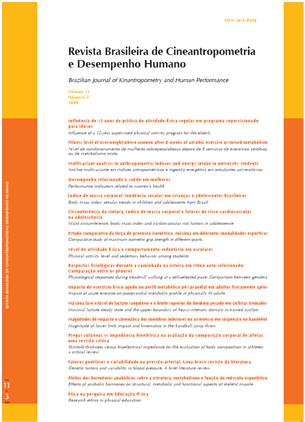Skinfold thickness versus bioelectrical impedance for the evaluation of body composition in athletes: a critical review
DOI:
https://doi.org/10.1590/1980-0037.2009v11n3p334Resumen
Body composition is a determinant factor for performance in different sports modalities. Safe, practical and validated instruments are necessary for the measurement of body composition and for the identification of alterations that occur during the training period. A critical review was performed comparing studies that apply skinfold thickness (SKF) and bioelectrical impedance (BIA) for the estimation of body composition in athletes. Studies published between 1990 and 2007 available online in the Pubmed, SportDiscus and Scielo databases were reviewed. Seven critical points were evaluated to rate the studies: number of subjects, performance level of the athletes studied, statistical methods applied, number of equations tested, test control, sample control, and gold standard used to compare the data. SKF and BIA present advantages for the assessment of body composition in athletes compared to other methods, such as their easy application, non-invasiveness and relatively low cost. The accuracy and reliability of the results obtained with these methods depend on test conditions, equations selected for data analysis and characteristics of the particular group (sports modality, gender, age and performance level). SKF seems to be a better method to estimate body composition in athletes because of the availability of specific equations for different sports modalities and because of the low sensitivity of BIA in detecting minimal alterations that occur during the training period.
Publicado
Número
Sección
Licencia

Direitos Autorais para artigos publicados nesta revista são do autor, com direitos de primeira publicação para a revista. Em virtude da aparecerem nesta revista de acesso público, os artigos são de uso gratuito, com atribuições próprias, em aplicações educacionais e não-comerciais, desde que seja dada a atribuição. Esta obra foi licenciada com uma Licença Creative Commons Atribuição 4.0 Internacional - CC BY


